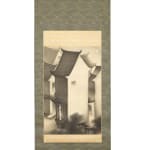Yasuda Hanpo
The Open Door in the Middle of the Night, 1922
Hanging scroll; ink and ink wash on silk
Overall size 71½ × 26 1⁄8 in. (181.5 × 66.5 cm)
Image size 30¼ x 19½ in. (77.3 x 50 cm)
Image size 30¼ x 19½ in. (77.3 x 50 cm)
T-3416
Further images
Signature: Drawn by Hanpo; seals: Seal of [Yasu]da Jun; Hanpo Comes with a fitted wooden storage box inscribed outside: Open Door at Dead of Night, a picture painted using the...
Signature: Drawn by Hanpo; seals: Seal of [Yasu]da Jun; Hanpo
Comes with a fitted wooden storage box inscribed outside: Open Door at Dead of Night, a picture painted using the suiboku technique; inscribed inside: During my studies last year in the Eastern Capital [Tokyo] I happened to meet Master Taikan and got the idea for this painting. I now present it to my friend Toyoda Hitoshi hoping it will make him laugh. Titled and inscribed by Hanpo Jun on an autumn day in 1922; seals: Seal of [Yasu]da Jun and Hanpo
This mysterious, atmospheric painting shows us a Chinese city late at night, with a full moon and the outlines of several two-story buildings by a river or lake. Through skillful use of ink lines and wash, Yasuda Hanpo expertly conveys a sense of dreamy silence and a darkness relieved only by moonlight. A single balcony door is open, revealing a female figure whose delicate features bear an enigmatic smile. The title offers no clue as to whether she is smiling in anticipation of a clandestine tryst or just delighting in the moonlit scenery.
Born in Niigata, Yasuda Hanpo was active in Osaka during the Taisho and early Showa eras. Thanks to his training under Mizuta Chikuho (1883 –1958) and Himejima Chikugai (1840 –1928), he excelled in Nanga-style ink painting and became a highly successful participant in national exhibitions, entering his first Bunten exhibition in 1917 and later showing at numerous Teiten exhibitions; in all, he took part in 22 national events of this kind. Known for his delicate and evocative landscape paintings, he was a founding member of the Nihon Nanga-in (National Academy of Nanga Painters).
This unusual composition dates from a period when many Japanese started to travel overseas. China was a particularly attractive destination for artists, not just because it was close by but also because it offered educated Japanese a chance to visit sites they had previously only been able to experience through Chinese literature and painting. Here Hanpo creates a view of Japan’s great continental neighbor and cultural mentor that is based partly on first-hand knowledge of traditional Chinese city architecture and partly on poems of the Tang and other dynasties that speak of lovers’ longings and dreamy midnight meetings.
The long inscription inside the box, appropriately enough written in classical Chinese, throws interesting light on connections within the Taisho-era art world. Hanpo speaks of a chance meeting with Yokoyama Taikan (1868 –1958), a giant of Nihonga painting, who gave him the idea for this composition; interestingly, Taikan too was going through a phase of painting Chinese scenes during these years, as can be seen through works he exhibited at national exhibitions.
Comes with a fitted wooden storage box inscribed outside: Open Door at Dead of Night, a picture painted using the suiboku technique; inscribed inside: During my studies last year in the Eastern Capital [Tokyo] I happened to meet Master Taikan and got the idea for this painting. I now present it to my friend Toyoda Hitoshi hoping it will make him laugh. Titled and inscribed by Hanpo Jun on an autumn day in 1922; seals: Seal of [Yasu]da Jun and Hanpo
This mysterious, atmospheric painting shows us a Chinese city late at night, with a full moon and the outlines of several two-story buildings by a river or lake. Through skillful use of ink lines and wash, Yasuda Hanpo expertly conveys a sense of dreamy silence and a darkness relieved only by moonlight. A single balcony door is open, revealing a female figure whose delicate features bear an enigmatic smile. The title offers no clue as to whether she is smiling in anticipation of a clandestine tryst or just delighting in the moonlit scenery.
Born in Niigata, Yasuda Hanpo was active in Osaka during the Taisho and early Showa eras. Thanks to his training under Mizuta Chikuho (1883 –1958) and Himejima Chikugai (1840 –1928), he excelled in Nanga-style ink painting and became a highly successful participant in national exhibitions, entering his first Bunten exhibition in 1917 and later showing at numerous Teiten exhibitions; in all, he took part in 22 national events of this kind. Known for his delicate and evocative landscape paintings, he was a founding member of the Nihon Nanga-in (National Academy of Nanga Painters).
This unusual composition dates from a period when many Japanese started to travel overseas. China was a particularly attractive destination for artists, not just because it was close by but also because it offered educated Japanese a chance to visit sites they had previously only been able to experience through Chinese literature and painting. Here Hanpo creates a view of Japan’s great continental neighbor and cultural mentor that is based partly on first-hand knowledge of traditional Chinese city architecture and partly on poems of the Tang and other dynasties that speak of lovers’ longings and dreamy midnight meetings.
The long inscription inside the box, appropriately enough written in classical Chinese, throws interesting light on connections within the Taisho-era art world. Hanpo speaks of a chance meeting with Yokoyama Taikan (1868 –1958), a giant of Nihonga painting, who gave him the idea for this composition; interestingly, Taikan too was going through a phase of painting Chinese scenes during these years, as can be seen through works he exhibited at national exhibitions.
Publications
Catalog 2013.18











